Cockatoos and their allies (corellas and the Cockatiel) are parrots that belong to the Cacatuidae family, which is placed in the Psittaciformes order. The family comprises 21 species in 8 genera.
They are known as Australasian cockatoos because they’re mainly found in mainland Australia, but some are also distributed in the Phillippines, Indonesia, New Guinea, and the Solomon Islands.
Cockatoos have interesting features such as prominent crests and solid, curved beaks. While their crests are often impressive, they don’t show them consistently, so they can look quite different depending on whether the crest is up or not.
They also have an interesting toe arrangement on the feet; the two outer toes face the back, and the two middle toes face the front. That makes them zygodactyl, and it enables them to grip perches and other objects firmly. The zygodactyl arrangement also allows them to pick up food with one of their feet while perched.
They range in color from plain white to a multitude of colors. Cockatoos feed on seeds, fruit, flowers, insects, and tubers. You’ll often see large flocks or small groups of cockatoos feeding or flying together. When it comes to nesting, cockatoos use holes in trees.
The 21 types of Australasian cockatoos will be described in the following article.
The Blue-eyed Cockatoo is a large parrot with primarily white plumage, a whitish-yellow crest, and blue eye rings. The underwing and undertail have a yellow wash.
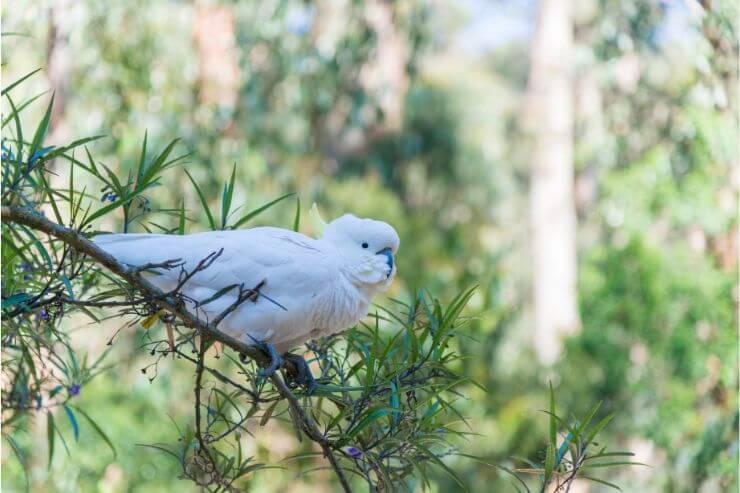
They have dark eyes and a black beak. They are endemic to Papua New Guinea, where they live in New Britain in lowland tropical forests.
The Red-vented Cockatoo is a large white parrot with yellow cheeks, underwings, and undertail. The vent is red, the beak is pale, and the eye is dark.
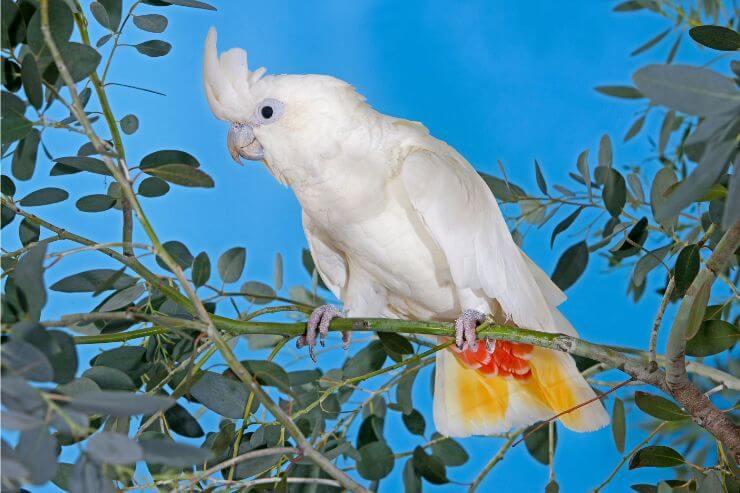
They only occur in the Palawan archipelago in the Philippines. They live in mangrove swamps, forests, and sometimes on farmlands.
The Salmon-crested Cockatoo has white plumage overall, with a pinkish wash on some feathers and a deep salmon-colored crest. The tail and wings are yellow on the underside, while the eye and beak are dark.
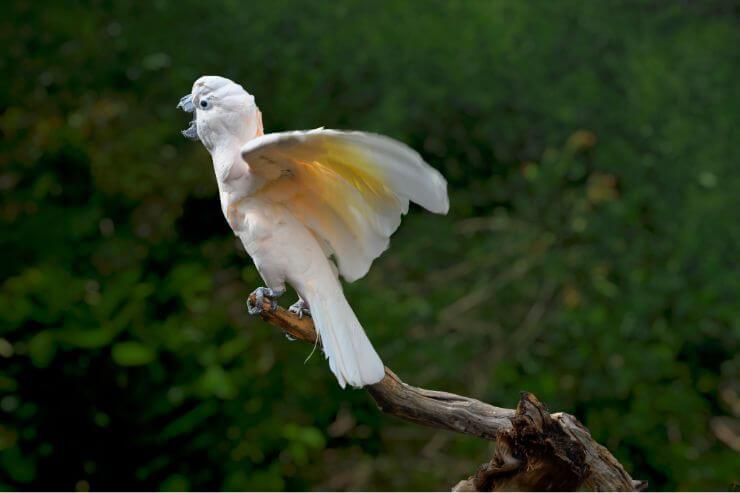
They are endemic to Indonesia, where they occur in the Seram archipelago. In terms of habitat, they favor lowland forests.
Solomons Cockatoo is a small white parrot with light blue eye rings, dark eyes, and a pale beak. A brown wash is sometimes visible on the chest and belly, while the underwing and undertail are yellowish.
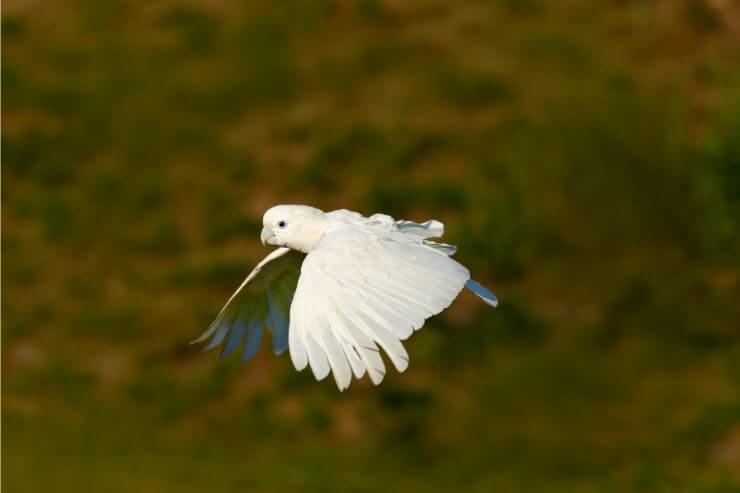
They are endemic to the Solomon Islands archipelago and found in lowland forests, open areas, and yards.
The Sulphur-crested Cockatoo has a plain white body, a dark bill, and a yellow crest. The underwing and undertail have a yellow wash. The male birds have black eyes, and the female birds have brownish-red eyes.
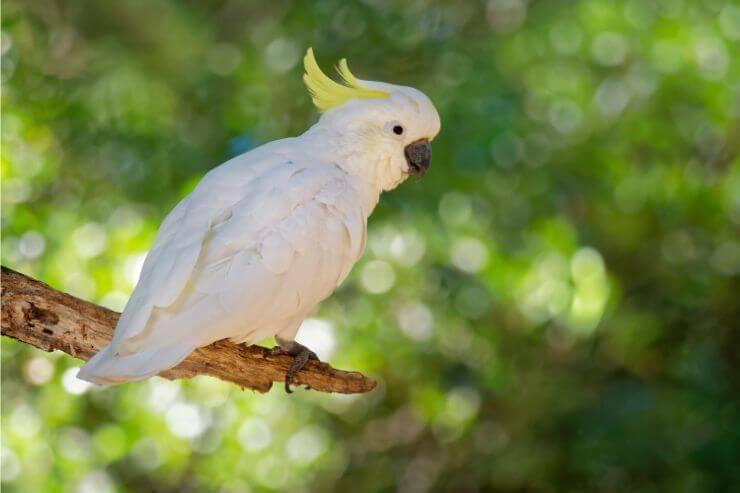
The native range of this large parrot is in Australia, New Guinea, and the Aru Islands in Indonesia. They inhabit woodlands, parks, and yards.
The White Cockatoo is a medium-sized parrot with all-white plumage, including the crest. The underwings and undertail have a hint of yellow, and the beak is dark grey.
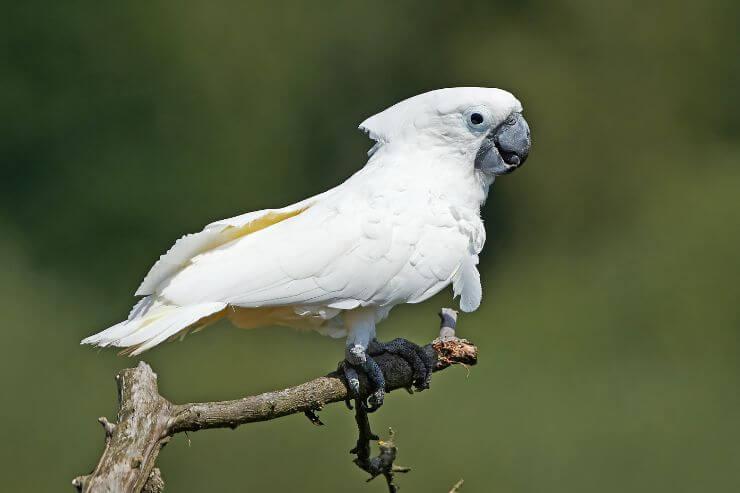
Other than by size, female White Cockatoos may be separated from the males by having reddish-brown eyes, while the males have dark brown eyes. They live in tropical rainforests in the Moluccan Islands.
The Yellow-crested Cockatoo is white overall, with a yellow patch on each ear, a yellow crest, a dark beak, and dark eyes. Their underwings and undertails are washed in yellow.
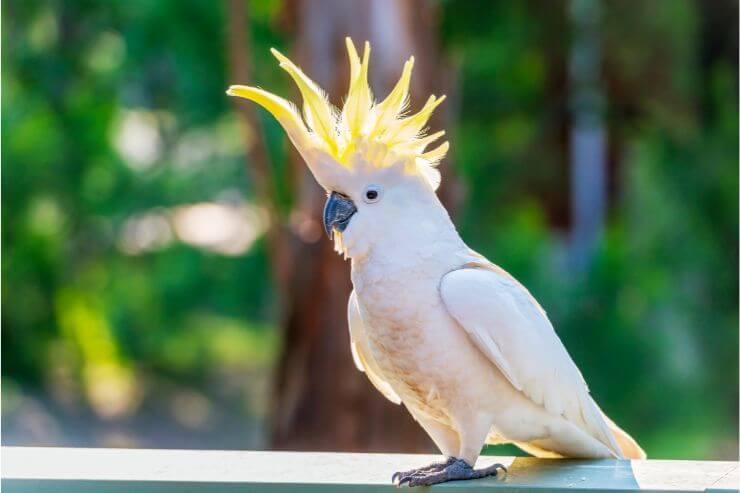
This medium-sized parrot is native to Indonesia and occurs in forests, forest edges, and open scrubland.
The Little Corella is a small white parrot with white plumage overall. Blue eye rings surround their dark eyes, and a pink patch is present between the eyes and the pale beak.

They have a yellow wash on the underwing and undertail. They are found in Australia and New Guinea, where they inhabit many habitats, including deserts, coastal plains, and urban areas.
The Long-billed Corella is white, with a dark eye, a pale blue eye ring, and reddish-pink patches between the eye and pale beak, as well as on the chin.
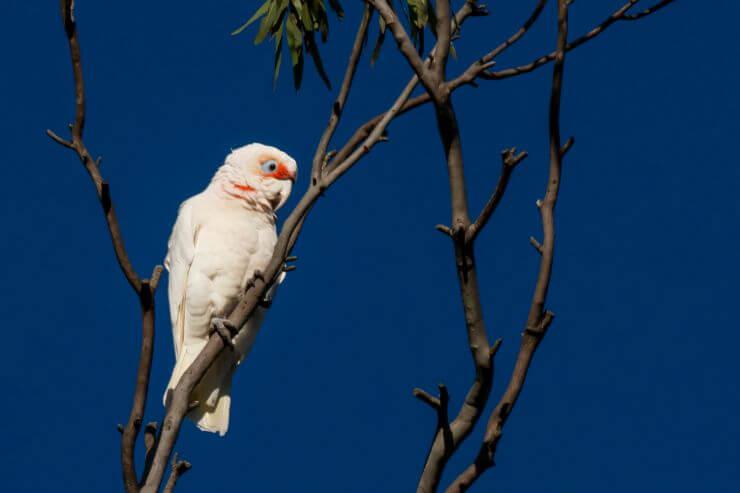
The undertail and underwings are yellow-washed. This medium-sized parrot occurs in grasslands, woodlands, parks, and fields. They are native to southeastern Australia.
The Tanimbar Corella is a small white parrot with greyish-blue eye rings and a pinkish patch between the pale grey beak and the eyes. Their undertail and underwings are yellow-tinted.
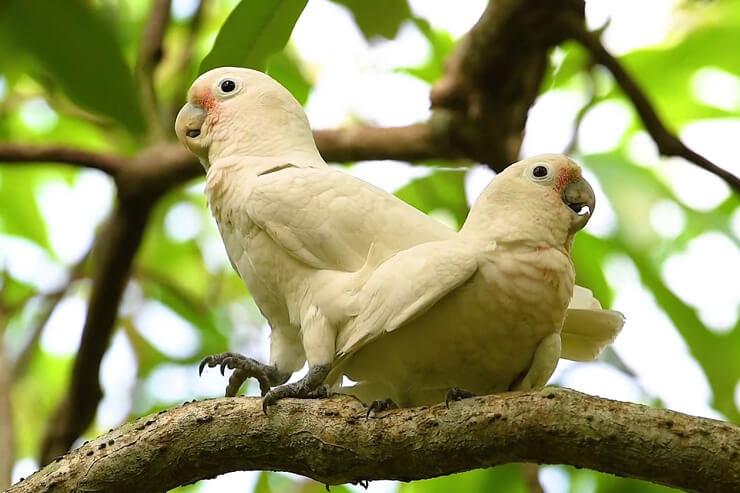
The eyes of males are black, and the eyes of females are brown. They naturally occur in the Tanimbar Islands archipelago of Indonesia. They live in forests and agricultural areas.
The Western Corella is a small parrot with a tiny crest. This species is white overall, with a pink marking between the eyes and the relatively pale beak.

They have yellow-tinted underwings and undertail. The eye is dark with a pale blue eye ring. They only occur in southwestern Australia. Their favored habitats are farmlands and wooded areas.
The Gang-gang Cockatoo is a small parrot with a scaly appearance. They are greenish grey throughout their bodies, with dark eyes, a grey eye ring, and pale beaks. A red head and crest are seen on males.
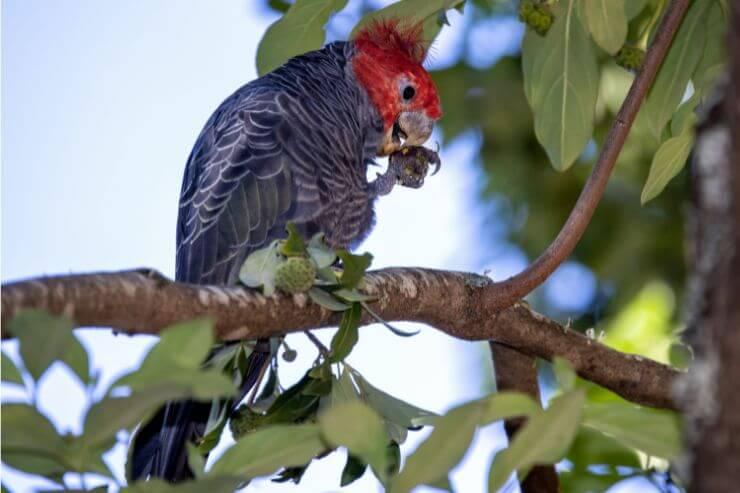
Females have grey heads, crests, and underside feathers with pinkish-salmon edges. They are restricted to southeastern Australia. They live in forests, woodlands, parks, and yards.
The Glossy Black Cockatoo is a relatively small parrot with brownish-black plumage and a browner head. Both sexes have dark eyes and grey beaks, but the male differs from the female by having red feathers on the tail.
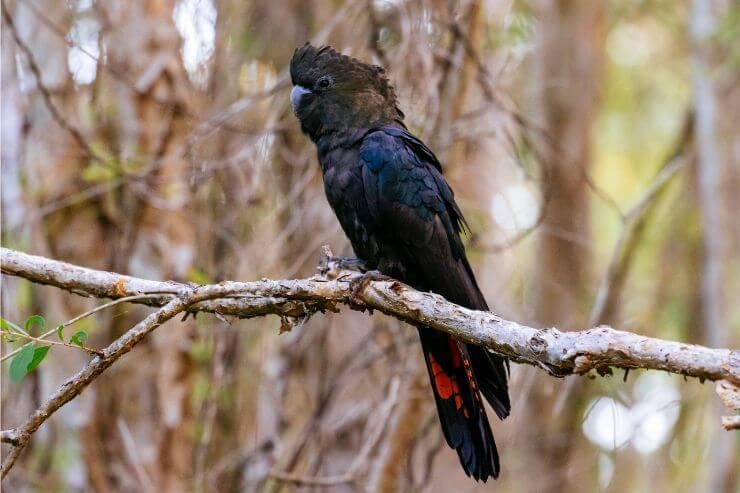
Females have yellow patches on their necks and faces and orange-red feathers on their tails. They live in eastern Australia. They occur in open woodlands and forests.
The Red-tailed Black Cockatoo has black plumage and dark eyes. Males have two red tail panels and a dark grey beak. Females have yellow to yellow-orange bars on the tail and chest, while the face and wings have yellow to red spots.
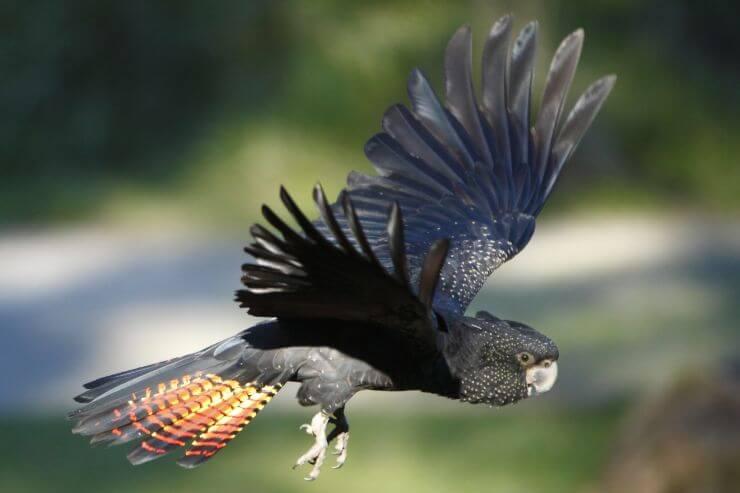
Females also have horn-colored beaks. This large parrot is found in Australia, where they live in Eucalyptus woodlands, shrublands, grasslands, and rainforests.
The Galah is a large, beautiful parrot. They have grey upper parts, pink underparts, necks and faces, a whitish-pink crown and crest, and a pale beak. The female of this species has pink eyes. On the other hand, the males have dark brown eyes.
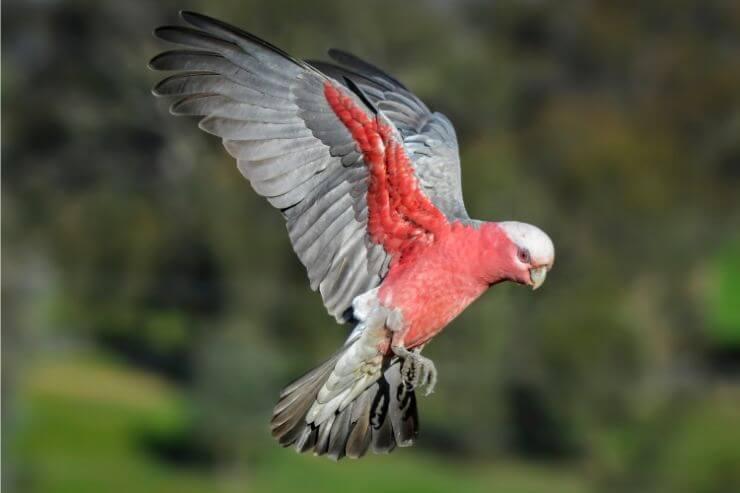
They are widespread across Australia in many habitats, including open woodlands, fields, agricultural areas, shrublands, grasslands, parks, yards, and other urban areas.
Major Mitchell’s Cockatoo is a small, distinctive cockatoo with pale pink underparts and white upper parts. They have large colorful crests, with white at the top and red and yellow at the bottom.
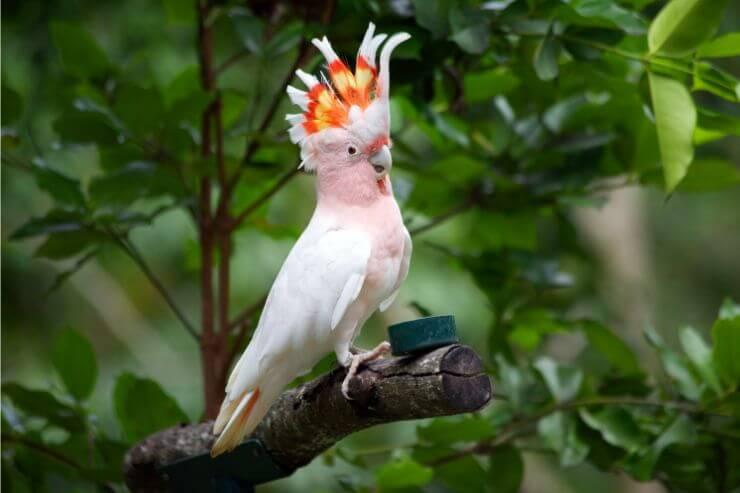
The underwings are pink, the bill is pale, and a red patch borders the beak. Male and female birds are differentiated by eye color – pink or red in females and dark brown in males.
They live in the inland areas of Australia, where they occur in arid and semi-arid habitats such as woodlands, scrublands, wooded grasslands, and savannahs.
The Cockatiel is a small, long-tailed parrot. They have grey bodies with large white wing patches, dark eyes, a grey bill, and paler undersides. Males have yellowish-white faces, yellow crests, and orange patches on the cheeks.

The females are greyer in the areas where the males are colorful, and they have spots and barring on the undertail and underwings that the males lack. They occur in arid and semi-arid habitats (usually near water) and are native to Australia.
The Palm Cockatoo is an impressive, large-crested parrot. They have dark grey-black plumage with a sizeable dark beak, dark eyes, and a bright red patch on the cheeks.

They are found in New Guinea, the Aru Islands in Indonesia, and Australia’s Cape York Peninsula. They live in woodlands and rainforests.
Baudin’s Black Cockatoo is a small greyish-black cockatoo with a white panel on the tail, dark brown eyes, and white ear patches. Their feathers are edged in white, which gives them a scalloped appearance.

The male is separated from the female by the pink (instead of grey) eye rings and dark grey (instead of bone-colored) beak. They occur in the moist Eucalyptus forests of southwestern Australia.
Carnaby’s Black Cockatoo is a black parrot of medium size. They have white ear patches, white panels on the tail, and brown eyes. Their bodies are greyish-black with white edging on the feathers, making them look scalloped.
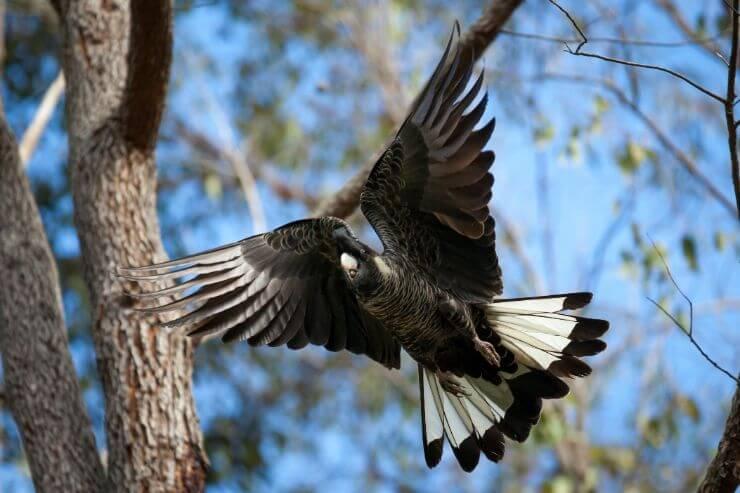
The females have bone-colored beaks and grey eye rings, while the males have dark grey beaks with pink eye rings. They are found in southwestern Australia. They inhabit many habitats, including pine plantations, parks, Eucalyptus woodlands, and agricultural lands.
The Yellow-tailed Black Cockatoo is a giant brownish-black cockatoo. They have yellow panels on the tail, yellow cheek patches, and dark eyes. Their bodies appear scalloped due to the yellow edges of the feathers.
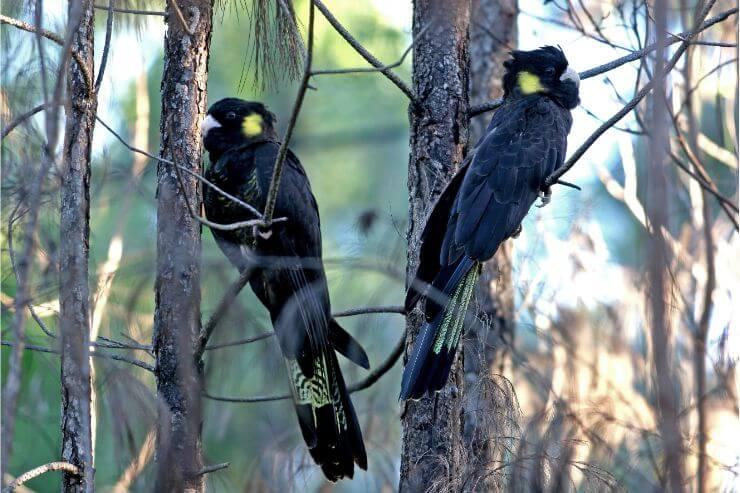
Males have black beaks and reddish-pink eye rings, while females have bone-colored beaks and grey eye rings. They are found in forests, pine plantations, urban areas, and Eucalyptus woodlands. They range throughout southeastern Australia.
Cockatoos are a diverse group of parrots native to the Australasian region. Cockatoos are long-lived birds that can live for up to 60 years in some species. However, many don’t live as long due to the threats they face.
Cockatoos and their allies are threatened severely by habitat loss and the capturing of wild birds for the pet trade. Habitat loss occurs when large trees are cleared, decreasing available nesting sites.
Population declines are often witnessed in many species due to their threats, but some species have shown increasing trends. The increases are often due to human expansion and more available food – owing to agricultural practices.
Because of their colorful plumages and outgoing natures, cockatoos are famous in the pet trade. The most well-known cage bird from the group is the Cockatiel, as it’s the easiest species to care for.
Many cockatoo species are listed as vulnerable to critically endangered due to their small distributions and threats. The Red-vented Cockatoo is an example of a critically endangered species, while the Sulphur-crested Cockatoo is so common it’s considered a pest.





